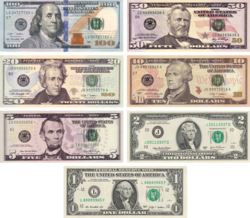- U.S. dollar, the official currency of the United States, the world's dominant reserve currency and the most traded currency globally.
- Euro, the currency used by the most countries and territories, the second-largest reserve currency and the second-most traded currency.
- The International Monetary Fund headquarters in Washington, D.C.. The IMF is primarily focused on the stability of the global monetary system and oversee the currencies of the world.
List of circulating currencies by state or territory
| Colour key and notes |
|---|
| Italics indicates a state or territory with a low level of international recognition |



